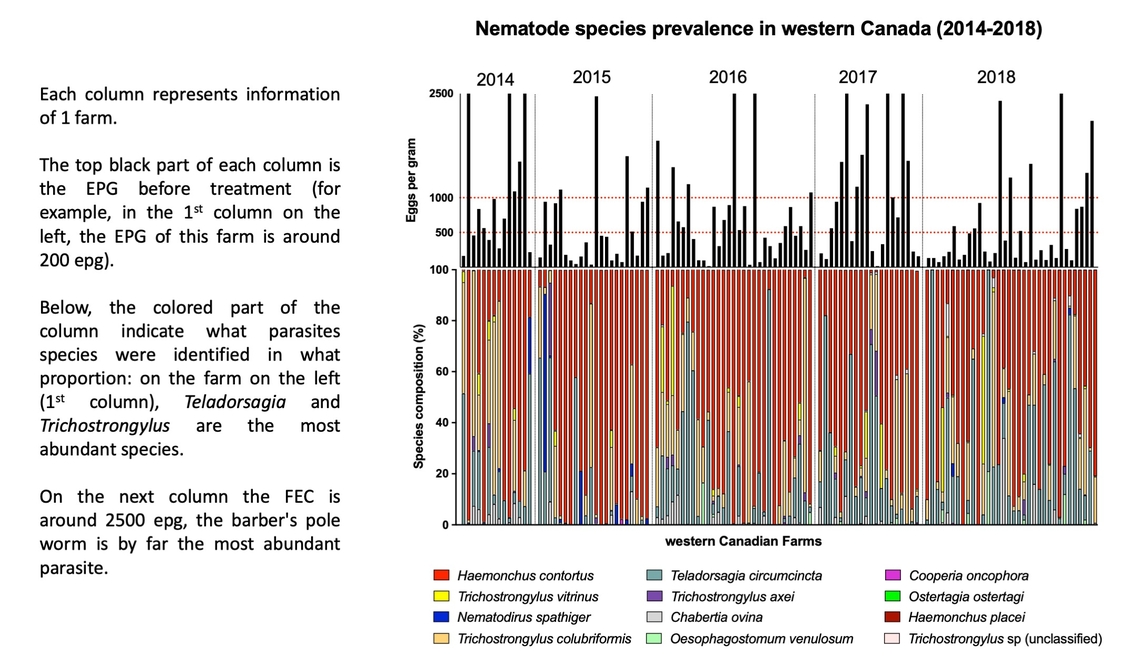Situation in Western Canada
What is the situation of gastrointestinal parasites in western Canada?
Before 2013, there was little information about the types of gastrointestinal (GI) parasites affecting western Canadian sheep and about the level of anthelmintic resistance. Since 2014, the University of Calgary Veterinary Medicine and the University of Saskatchewan Western College Of Veterinary Medicine have conducted research projects to identify the different GI parasites affecting western Canadian sheep flocks and the degree of anthelmintic resistance of these parasites.
Producers from British Columbia, Alberta, Saskatchewan and Manitoba are participating in the study.
Infection Intensity
Fecal egg Counts (FEC) are used to determine the severity of infection. Our research indicates that there is considerable variations between farms and that the results need to be interpreted with caution.
We determined the parasite infection intensities by performing fecal egg counts (FEC) on pooled fecal samples from about 20 ewes, sent by producers from British Columbia, Alberta, Saskatchewan and Manitoba. Results are expressed in eggs per gram (epg) and are shown in Figure 1.

Figure 1: Fecal egg count (FEC) of ewes in farms in western Canada before treatment
An average FEC of 500 epg or above in ewes is a cause for concern and warrants further investigation, but even with a lower epg, evaluation of the ewes for body condition, poor growth of the lambs is important as interpretation of FEC is not straightforward. It depends on the age of the animal, the type of parasite, the season, and the level of pasture infection. Results of the FEC should be discussed with your veterinarian.
How to perform a fecal egg count is illustrated in the video and the PDF document in the Resources page.
Importance of identifying species
Identifying species is important to understand the parasite situation. The current results of our research indicate that the Barber’s pole worm is the most common GI parasite present in western Canada.
We analysed the parasite species present in the fecal samples of sheep from the study flocks, using the Nemabiome, a molecular technique recently developed at University of Calgary (more information about the Nemabiome, is available in the resource page). Haemonchus contortus (barber’s pole worm) was identified as being the most prevalent species. Teladorsagia circumcincta (the brown stomach worm) and Trichostrongylus colubriformis are the second and third most common species of GI parasite in western Canadian flocks. See Figure 2
Knowing which worm species is present greatly increases the ability of a producer to know what infection signs to look for and to develop control strategies that will target the most prevalent species.

Figure 2: Nematode species prevalence survey in western Canada
Effectiveness of Dewormers
Commonly used dewormers such as ivermectin, fenbendazole and albendazole are often not effective in western Canada
Until recently, parasite control in Canada largely depended on the use of just two dewormer classes: ivermectin (Ivomec®, Ivermectin drench® and Noromectin®) and benzimidazoles (SafeGuard® and Valbazen®).
Efficacy of dewormers is evaluated using the Fecal Egg Count Reduction Test (see Dewormer resistance page). Ivermectin was not fully effective in 89% of the flocks treated and Benzimidazoles were not fully effective in 85% of the flocks. (a reduction in fecal egg count of at least 95% is the definition of fully effective). Results of our study are displayed in Figure 3 and 4.
Moreover, the study also looked at the effectiveness of ivermectin and benzimidazole dewormer treatments against each of the different roundworm species. For instance, if we look at figures 3 and 4 below, we can see the proportions of the different roundworm species present in each flock before and after treatment with the different classes of dewormer (samples taken from FECRT study)
In the case of benzimidazoles (Figure 3), the barber’s pole worm Haemonchus contortus (in red) is present in all samples “before treatment” (first column for each farm) and in all samples “after treatment” (second column for each farm). This means that this roundworm species is surviving the treatment with benzimidazole dewormers.

Figure 3. Species composition before and after treatment with ivermectin for each farm. Each pair of columns represent a different farm: the first column shows species composition before ivermectin treatment, second column shows species composition 14 days after treatment.

Figure 4. Species composition before and after treatment with benzimidazole for each farm. Every two columns represent a different farm: the first column shows species composition before benzimidazole treatment, second column shows species composition 14 days after treatment.
Key to roundworm control programs
In conclusion, monitoring fecal egg counts and identifying parasite species is a key to roundworm control programs
Only a few years ago the blood feeding barber’s pole worm Haemonchus contortus was not considered a major problem in western Canada: it is now shown to be most prevalent roundworm parasite in the region. The reasons for this are not entirely understood but likely to be a combination of emerging dewormer resistance, climate change and management changes. Also, just a few years ago the assumption was that dewormers worked well and resistance was not a problem in the region. All this emphasizes that producers need to be more aware of the risk of roundworm parasites, the need for monitoring and the need for evidence-based roundworm control programs.
